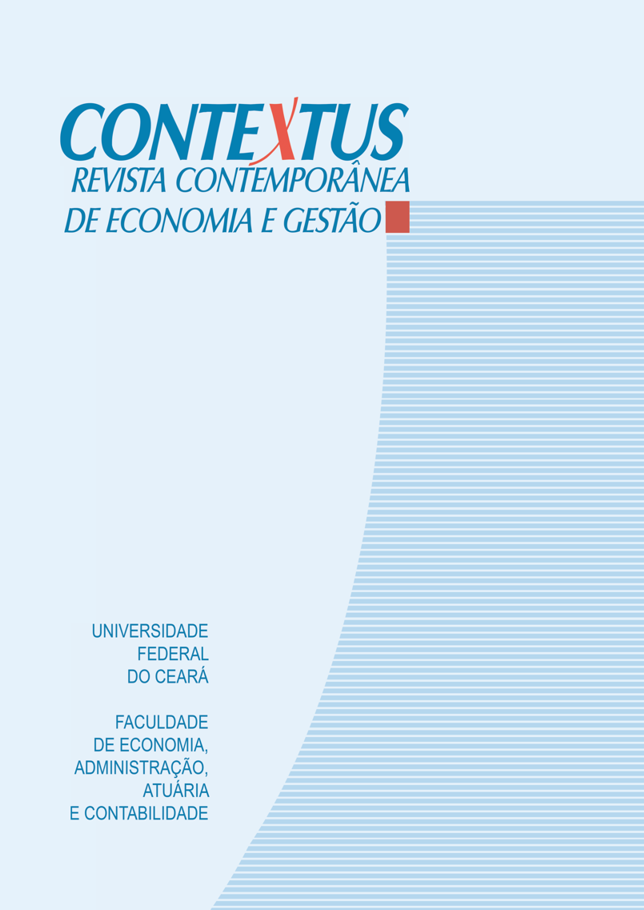Antecedentes de la adopción del Social Media Marketing por micro y pequeñas empresas
DOI:
https://doi.org/10.19094/contextus.2023.88631Palabras clave:
antecedentes, adopción de Social Media Marketing, micro y pequeñas empresas, modelado de ecuaciones estructurales, empresariosResumen
La adopción del Social Media Marketing (SMM) está cada vez más presente en las empresas. Sin embargo, poco se sabe sobre este fenómeno en el contexto de las micro y pequeñas empresas (MYPEs). La investigación analizó el proceso de adopción del SMM por las MYPEs, con 338 emprendedores vinculados al Sistema Brasileño de Apoyo a la Micro y Pequeña Empresa, utilizando el Modelado de Ecuaciones Estructurales. Se encontró que el conocimiento técnico, la reducción de costos, la presión de los clientes y competidores generan beneficios percibidos por los empresarios en relación al uso de la herramienta, lo que lleva a un mayor nivel de uso. El trabajo mostró el papel de los factores determinantes en la adopción por las MYPEs.
Citas
Alalwan, A. A., Rana, N. P., Dwivedi, Y. K., & Algharabat, R. (2017). Social media in marketing: A review and analysis of the existing literature. Telematics and Informatics, 34(7), 1177-1190. https://doi.org/10.1016/j.tele.2017.05.008
Alford, P., & Page, S. J. (2015). Marketing technology for adoption by small business. Service Industries Journal, 35, 655-669. https://doi.org/10.1080/02642069.2015.1062884
Almeida, M. I. S., Coelho, R. Li. F., Camargo, A., Filho, Gomes, A. C., & Porto, R. B. (2017). Marketing and social media long run performance implications : A time series experiment on small retailing. October.
Alsaleh, D. A., Elliott, M. T., Fu, F. Q., & Thakur, R. (2019). Cross-cultural differences in the adoption of social media. Journal of Research in Interactive Marketing, 13(1), 119-140. https://doi.org/10.1108/JRIM-10-2017-0092
Anderson, J. C., & Gerbing, D. W., (1988). Structural equation modeling in practice: a review and recommended two-step approach. Psychol. Bull, 103(3), 411-423.
Arantes, R. D. C., Pereira, M. M. O., Castro, C. C. D., Mineiro, A. A. D. C., & Oliveira, J. A. (2021). A transformação digital e o conhecimento organizacional: uma revisão sistemática da literatura. Revista Contemporânea de Economia e Gestão, 19, 316-329. https://doi.org/10.19094/contextus.2021.71301
Bagozzi, R.P., & Yi, Y. (1988). On the evaluation of structural equation models. Journal of the Academy of Marketing Science, 16, 74-94.
Byrne, B. M. (2013). Structural equation modeling with Mplus: Basic concepts, applications, and programming. New York: Routledge.
Chatterjee, S., & Kumar Kar, A. (2020). Why do small and medium enterprises use social media marketing and what is the impact: Empirical insights from India. International Journal of Information Management, 53, 102-103. https://doi.org/10.1016/j.ijinfomgt.2020.102103
Choi, Y., & Thoeni, A. (2016). Social media: is this the new organizational stepchild? European Business Review, 28(1), 21-38. https://doi.org/10.1108/EBR-05-2015-0048
Cohen, J. (1988). Statistical power analysis for the behavioral sciences. (2th ed.). Hillsdale, NJ: Erlbaum.
Cronbach, L. J. (1951). Coefficient alpha and the internal structure of tests. Psychometrika, 16(3), 297-334.
Dahnil, M. I., Marzuki, K. M., Langgat, J., & Fabeil, N. F. (2014). Factors Influencing SMEs Adoption of Social Media Marketing. Procedia - Social and Behavioral Sciences, 148, 119-126. https://doi.org/10.1016/j.sbspro.2014.07.025
Eid, R., Abdelmoety, Z., & Agag, G. (2020). Antecedents and Consequences of Social Media Marketing Use: An Empirical Study of the UK Exporting B2B SMEs. Journal of Business and Industrial Marketing, 35(2), 284-305.
Eze, S. C., Chinedu-Eze, V. C. A., & Awa, H. O. (2021). Key Success Factors (KSFs) Underlying the Adoption of Social Media Marketing Technology. SAGE Open, 11(2). https://doi.org/10.1177/21582440211006695
Fornell, C., & Larcker, D.F. (1981). Evaluating structural equation models with unobservable variables and measurement error. Journal of Marketing Research, 18(1), 39-50.
Gonçalves, A., Nascimento, L., Bouzada, M., & Pitassi, C. (2016). Fatores que impactam na adoção e implementação do sped na avaliação dos gestores das empresas brasileiras. Journal of Information Systems and Technology Management, 13(2), 193–218. https://doi.org/10.4301/s1807-17752016000200003
Gutierrez-Leefmans, C., Nava-Rogel, R. M., & Trujillo-León, M. A. (2019). How Are dynamic capabilities and digital marketing related? A reflection from literature. Revista Eletrônica de Estratégia & Negócios, 11(3), 265-283. https://doi.org/10.19177/reen.v11e32018265-283
Hair, J. F., Black, W.C., Babin, B. J., Anderson, R. E., & Tatham, R. L. (2018). Multivariate Data Analysis (8th ed.). London: Pearson.
Kaplan, A. M., & Haenlein, M. (2010). Users of the world, unite! The challenges and opportunities of social media. Business Horizons, 53(1), 59-68. https://doi. org/10.1016/j.bushor.2009.09.003
Kline, R. B. (2011). Convergence of structural equation modeling and multilevel modeling. In M. Williams (Ed.), Handbook of Methodological Innovation. California: Sage, Thousand Oaks.
Kumar, A., Syed, A. A., & Pandey, A. (2021). Adoption of online resources to improve the marketing performance of SMES. Asia Pacific Journal of Health Management, 16(3), 137-144.
Kumar, A., & Möller, K. (2018). Extending the boundaries of corporate branding: An exploratory study of the influence of brand familiarity in recruitment practices through social media by B2B firms. Corporate Reputation Review, 21(3), 101-114. https://doi.org/10.1057/s41299-018-0046-7
Li, F., Larimo, J., & Leonidou, L. C. (2023). Social media in marketing research: Theoretical bases, methodological aspects, and thematic focus. Psychology and Marketing, 40(1), 124-145. https://doi.org/10.1002/mar.21746
Malhotra, N. K. (2019). Pesquisa de marketing: uma orientação aplicada. (7 ed.). Porto Alegre: Bookman.
Matikiti, R., Mpinganjira, M., & Roberts-Lombard, M. (2018). Application of the Technology Acceptance Model and the Technology–Organisation–Environment Model to examine social media marketing use in the South African tourism industry. SA Journal of Information Management, 20(1), 1-12. https://doi.org/10.4102/sajim.v20i1.790
Melo, C. O., Luft, M. C. M. S., & Rocha, R. O. (2021). Influencing elements of technological adoption: Case study about management in an educational institution. Contextus – Revista Contemporânea de Economia e Gestão, 19, 124-145. https://doi.org/10.19094/contextus.2021.61445
Pandey, N., Nayal, P., & Rathore, A. S. (2020). Digital marketing for B2B organizations: structured literature review and future research directions. Journal of Business and Industrial Marketing, 35(7), 1191-1204. https://doi.org/10.1108/JBIM-06-2019-0283
Patma, T. S., Wardana, L. W., Wibowo, A., & Narmaditya, B. S. (2020). The Shifting of Business Activities during the COVID-19 Pandemic: Does Social Media Marketing Matter? Journal of Asian Finance, Economics and Business, 7(12), 283-292. https://doi.org/10.13106/JAFEB.2020.VOL7.NO12.283
Picoto, W. N., Crespo, N. F., & Carvalho, F. K. (2021). The Influence of the Technology-Organization-Environment Framework and Strategic Orientation on the Use of Cloud Computing, Enterprise Mobility and Performance. Revista Brasileira de Gestao de Negócios, 23(2), 278-300. https://doi.org/10.7819/rbgn.v23i2.4105
Porter, C. E., & Donthu, N. (2006). Using the technology acceptance model to explain how attitudes determine Internet usage: The role of perceived access barriers and demographics. Journal of Business Research, 59, 999-1007. https://doi. org/10.1016/j.jbusres.2006.06.003
Praveena, K., & Thomas, S. (2014). Intenção de continuar a usar o Facebook: um estudo de prazer percebido e TAM. Bonfring International Journal of Industrial Engineering and Management Science , 4(1), 24-29.
Ratnasingam, J., Ioras, F., Liat, L., Ayenkaren, J., Yi, L., & Labtib, H. A. (2021). Digital technology application among Malaysian value-added wood products manufacturers. BioResources, 16(2), 2876-2890.
Salwani, M. I., Marthandan, G., Norzaidi, M. D., & Chong, S. C. (2009). E-commerce usage and business performance in the Malaysian tourism sector: Empirical analysis. Information Management & Computer Security, 17(2), 166-185. https:// doi.org/10.1108/09685220910964027
Santos, S. S. S., Begnini, S., & Carvalho, C. E. (2020). O efeito do uso das mídias sociais e das capacidades dinâmicas no desempenho mercadológico de micro, pequenas e médias empresas. Revista Brasileira de Marketing, 19(1), 174-196. https://doi.org/10.5585/remark.v19i1.17346
Sarin, P., Kar, A. K., & Ilavarasan, V. P. (2021). Exploring engagement among mobile app developers – Insights from mining big data in user generated content. Journal of Advances in Management Research, 18(4), 585-608.
Serviço Brasileiro de Apoio às Micro e Pequenas Empresas. (2020). Pequenos negócios em números. https://www.sebrae.com.br/sites/PortalSebrae/ufs/sp/sebraeaz/pequenos-negocios-em-numeros,12e8794363447510VgnVCM1000004c00210aRCRD
Shen, G. C. (2015). Como a qualidade de vida afeta a intenção de usar sites de redes sociais: Papel moderador da auto-revelação. Journal of Electronic Commerce Research, 16(4), 276-289.
Silva, S. C. E., Duarte, P. A. O., & Almeida, S. R. (2020). How companies evaluate the ROI of social media marketing programmes: insights from B2B and B2C. Journal of Business and Industrial Marketing, 35(12), 2097-2110. https://doi.org/10.1108/JBIM-06-2019-0291
Souza, C. A., Siqueira, É. S., & Reinhard, N. (2017). Digital divide of small and medium-sized enterprises: An analysis of influencing factors using the toe theory. Revista de Administração Mackenzie, 18(2), 15-48. https://doi.org/10.1590/1678-69712017/administracao.v18n2p15-48
Tarsakoo, P., & Charoensukmongkol, P. (2019). Dimensions of social media marketing capabilities and their contribution to business performance of firms in Thailand. Journal of Asia Business Studies, 14(4), 441-461. https://doi.org/10.1108/JABS-07-2018-0204
Tornatzky, L. G., & Fleischer, M. (1990). Processo de inovação tecnológica. Massachusetts: Lexington Books.
Tukey, J. W. (1977). Some thoughts on clinical trials, especially problems of multiplicity. Science, 198(4318), 679-684.
Wanyoike, D. M., Mukulu, E., & Waititu, A. G. (2012). ICT attributes as determinants of e-commerce adoption by formal small enterprises in urban Kenya. International Journal of Business and Social Science, 3(23), 65-74.
Yao, B., Shanoyan, A., Peterson, H. H., Boyer, C., & Baker, L. (2019). The use of new-media marketing in the green industry: Analysis of social media use and impact on sales. Agribusiness, 35(2), 281-297. https://doi.org/10.1002/agr.21581
Yilmaz, H. (2018). Measuring egocentric, adaptive and pathological forms of selfishness: scale adaptation study. J. Acad. Soc. Sci., 6(74), 45-57.
Zhu, K., & Kraemer, K. L. (2005). Variações pós-adoção no uso e valor de e negócios por organizações: Evidências cross-country da indústria de varejo. Pesquisa de Sistemas de Informação, 16(1), 61-84. https://doi.org/10.1287/isre.1050
Descargas
Publicado
Cómo citar
Número
Sección
Licencia
Derechos de autor 2023 Journal: only for the 1st publication

Esta obra está bajo una licencia internacional Creative Commons Atribución-NoComercial 4.0.
Os autores, no ato da submissão, aceitam a declaração abaixo:
Nós autores mantemos sobre nosso artigo publicado os direitos autorais e concedemos à revista Contextus o direito de primeira publicação, com uma licença Creative Commons na modalidade Atribuição – Não Comercial 4.0 Internacional, a qual permite o compartilhamento com reconhecimento da autoria e da publicação inicial nesta revista.
Temos ciência de estarmos autorizados a assumir contratos adicionais separadamente, para distribuição não exclusiva da versão do trabalho publicada nesta revista (ex.: publicar em repositório institucional ou como capítulo de livro), também com reconhecimento tanto da autoria, quanto da publicação inicial neste periódico.
Atestamos que o artigo é original ou inédito, não foi publicado, até esta data, em nenhum periódico brasileiro ou estrangeiro, quer em português, quer em versão em outra língua, nem está encaminhado para publicação simultânea em outras revistas.
Sabemos que o plágio não é tolerado pela revista Contextus e asseguramos que o artigo apresenta as fontes de trechos de obras citadas, incluindo os de qualquer trabalho prévio produzido e publicado pelos próprios autores.









3.png)


1.jpg)



1.jpg)


1.jpg)






.jpg)



1.jpg)

1.jpg)


1.jpg)

1.jpg)
1.jpg)
2.png)




1.jpg)
2.jpg)

1.jpg)





1.jpg)


1.jpg)
1.jpg)
